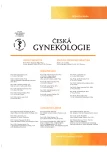Idiopathic polyhydramnios
Authors:
J. Matěcha 1
; Marta Nováčková 2
Authors‘ workplace:
Lékařská fakulta UK, Plzeň
1; Gynekologicko‑porodnická klinika 1. LF UK a Nemocnice Na Bulovce, Praha, přednosta prof. MUDr. M. Zikán, Ph. D.
1; Gynekologicko‑porodnická klinika 2. LF UK a FN Motol, Praha, přednosta doc. MUDr. R. Chmel, Ph. D., MHA
2
Published in:
Ceska Gynekol 2020; 85(6): 417-421
Category:
Review Article
Overview
Objective: A comprehensive overview on idiopathic polyhydramnios and associated complications.
Design: Review article.
Setting: Department of Obstetrics and Gynaecology, First Faculty of Medicine, Charles University and Hospital Na Bulovce, Prague, Czech Republic; Department of Obstetrics and Gynaecology, Second Faculty of Medicine, Charles University and Motol University Hospital, Prague, Czech Republic.
Methods: Literature search using the databases Web of Science, Ovid, Cochrane, Medline databases and an analysis of articles published in peer-reviewed journals with impact factor in the years 1958–2020.
Results: Polyhydramnios occurs in 0.2–2% of pregnancies. Pregnancies with polyhydramnios are more often complicated by abnormal foetal lie or presentation and, moreover, should be associated with adverse pregnancy outcomes, particularly with the higher incidence of intrauterine foetal death, placental abruption, labour induction, caesarean sections, prolonged first stage of labor and shoulder dystocia.
Conclusion: The moderate and severe forms of idiopathic polyhydramnios are associated with the higher risk of adverse pregnancy outcomes that implies the need for intensive monitoring of a pregnant woman and the foetus both in pregnancy and during the delivery itself.
Keywords:
amniotic fluid index – caesarean section – deepest vertical pocket – idiopathic polyhydramnios – intrauterine death
Sources
1. Aviram, A., Salzer, L., Hiersch, L., et al. Association of isolated polyhydramnios at or beyond 34 weeks of gestation and pregnancy outcome. Obstet Gynecol, 2015, 125(4), p. 825–832.
2. Dashe, JS., McIntire, DD., Ramus, RM., et al. Hydramnios: anomaly prevalence and sonographic detection. Obstet Gynecol, 2002, 100(1), p. 134–139.
3. Dorleijn, DMJ., Cohen-Overbeek, TE., Groenendaal, F., et al. Idiopathic polyhydramnios and postnatal findings. J Matern Fetal Neonatal Med, 2009, 22(4), p. 315–320.
4. Dickinson, JE., Tjioe, YY., Jude, E., et al. Amnioreduction in the management of polyhydramnios complicating singleton pregnancies. Am J Obstet Gynecol, 2014, 211(4), 434, p. e1–7.
5. Erfani, H., Diaz-Rodriguez, GE., Aalipour, S., et al. Amnioreduction in cases of polyhydramnios: indications and outcomes in singleton pregnancies without fetal interventions. Eur J Obstet Gynecol Reprod Biol, 2019, 241, p. 126–128.
6. Hamza, A., Herr, D., Solomayer, EF., Meyberg-Solomayer, G.Polyhydramnios: causes, diagnosis and therapy. Geburtshilfe Frauenheilkd, 2013, 73(12), p. 1241–1246.
7. Harlev, A., Sheiner, E., Friger, M., Hershkovitz, R. Polyhydramnios and adverse perinatal outcome – what is the actual cutoff? J Maternal-Fetal Neonatal Med, 2014, 27(12), p. 1199–1203.
8. Hughes, DS., Magann, EF., Whittington, JR., et al. Accuracy of the ultrasound estimate of the amniotic fluid volume (Amniotic Fluid Index and Single Deepest Pocket) to identify actual low, normal, and high amniotic fluid volumes as determined by quantile regression. J Ultrasound Med, 2020, 39(2), p. 373–378.
9. Khan, S., Donnelly, J. Outcome of pregnancy in women diagnosed with idiopathic polyhydramnios. Aust N Z J Obstet Gynaecol, 2017, 57(1), p. 57–62.
10. Kováčová, H., Matura, D., Šimetka, O., et al. Vzácné formy feto-fetální transfuze v klinické praxi. Čes Gynekol, 2017, 82(3), s. 190–196.
11. Ľubušký, M., Krofta, L., Vlk, R. Pravidelná ultrazvuková vyšetření v průběhu prenatální péče – doporučený postup. Čes Gynekol. 2013, 78(2), s. 134–135
12. Luo, QQ., Zou, L., Gao, H., et al. Idiopathic polyhydramnios at term and pregnancy outcomes: a multicenter observational study. J Maternal-Fetal Neonatal Med, 2017, 30(14), p. 1755–1759.
13. Magann, EF., Chauhan, SP., Doherty, DA., et al. A review of idiopathic hydramnios and pregnancy outcomes. Obstet Gynecol Surv, 2007, 62(12), p. 795–802.
14. Many, A., Hill, LM., Lazebnik, N., et al. The association between polyhydramnios and preterm delivery. Obstet Gynecol, 1995, 86, p. 389–391.
15. Maymon, E., Ghezzi, F., Shoham-Vardi, I., et al. Isolated hydramnios at term gestation and the occurrence of peripartum complications. Eur J Obstet Gynecol Reprod Biol, 1998, 77(2), p. 157–161.
16. Odibo, IN., Newville, TM., Ounpraseuth, ST., et al. Idiopathic polyhydramnios: persistence across gestation and impact on pregnancy outcomes. Eur J Obstet Gynecol Reprod Biol, 2016, 199, p. 175–178.
17. Phelan, JP., Ahn, MO., Smith, CV., et al. Amniotic fluid index measurements during pregnancy. J Reprod Med, 1987, 32(8), p. 601–604.
18. Pilliod, RA., Page, JM., Burwick, RM., et al. The risk of fetal death in nonanomalous pregnancies affected by polyhydramnios. Am J Obstet Gynecol, 2015, 213(3), p. e1–6.
19. Practice Bulletin No. 175: Ultrasound in pregnancy. Obstet Gynecol, 2016, 128(6), p. e242–e256.
20. Queenan, JT., Thompson, W., Whitfield, CR., Shah, SI. Amniotic fluid volumes in normal pregnancies. Am J Obstet Gynecol, 1972, 114(1), p. 34–38.
21. Ross, MG., Nijland, MJ. Fetal swallowing: Relation to amniotic fluid regulation. Clin Obstet Gynecol, 1997, 40(2), p. 352–365.
22. Sagi-Dain, L., Sagi, S. Chromosomal aberrations in idiopathic polyhydramnios: a systematic review and meta-analysis. Eur J Med Genet, 2015, 58(8), p. 409–415.
23. Society for Maternal-Fetal Medicine, Dashe, JS., Pressman, EK., Hibbard, JU. SMFM consult series #46: evaluation and management of polyhydramnios. Am J Obstet Gynecol, 2018, 219(4), p. B2–B8.
24. Wiegand, SL., Beamon, CJ., Chescheir, NC., Stamilio, D. Idiopathic polyhydramnios: severity and perinatal morbidity. Am J Perinatol, 2016, 33(7), p. 658–664.
25. Zeino, S., Carbillon, L., Pharisien, I., et al. Delivery outcomes of term pregnancy complicated by idiopathic polyhydramnios. J Gynecol Obstet Hum Reprod, 2017, 46(4), p. 349–354.
Labels
Paediatric gynaecology Gynaecology and obstetrics Reproduction medicineArticle was published in
Czech Gynaecology

2020 Issue 6
Most read in this issue
- Idiopathic polyhydramnios
- Total laparoscopic hysterectomy – clinical comparison of the method using two types of uterine manipulators
- Dienogest in the treatment of endometriosis
-
Importance of addition of HPV DNA testing to the cytology based cervical cancer screening and triage of findings with p16/Ki67 immunocytochemistry staining in 35 and 45 years old women
LIBUSE trial data analysis
